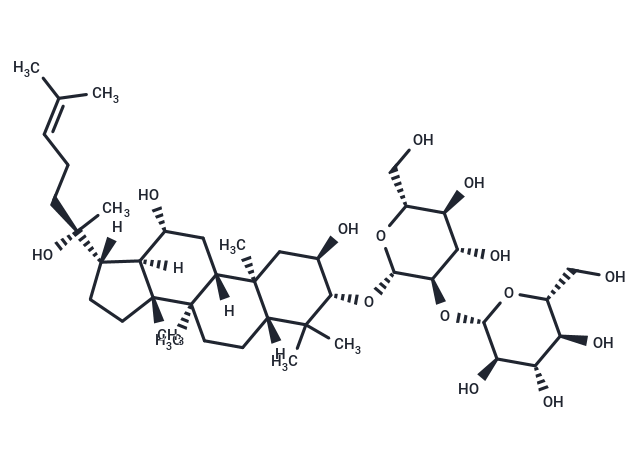Shopping Cart
Remove All Your shopping cart is currently empty
Your shopping cart is currently empty
Gypenoside L inhibits autophagic flux and induces cell death in human esophageal cancer cells through endoplasm reticulum stress-mediated Ca2+ release. It also inhibit non-small cell lung carcinoma A549 cell inhibitory activity.

| Pack Size | Price | USA Warehouse | Global Warehouse | Quantity |
|---|---|---|---|---|
| 1 mg | $108 | In Stock | In Stock | |
| 5 mg | $272 | In Stock | In Stock | |
| 10 mg | $397 | In Stock | In Stock | |
| 25 mg | Preferential | In Stock | In Stock | |
| 50 mg | Preferential | - | In Stock |
| Description | Gypenoside L inhibits autophagic flux and induces cell death in human esophageal cancer cells through endoplasm reticulum stress-mediated Ca2+ release. It also inhibit non-small cell lung carcinoma A549 cell inhibitory activity. |
| In vitro | gypenoside L (Gyp-L), a saponin isolated from Gynostemma pentaphyllum, on cancer cell growth.?We found that Gyp-L increased the SA-β-galactosidase activity, promoted the production of senescence-associated secretory cytokines, and inhibited cell proliferation of human liver and esophageal cancer cells.?Moreover, Gyp-L caused cell cycle arrest at S phase, and activated senescence-related cell cycle inhibitor proteins (p21 and p27) and their upstream regulators.?In addition, Gyp-L activated p38 and ERK MAPK pathways and NF-κB pathway to induce senescence.?Consistently, adding chemical inhibitors efficiently counteracted the Gyp-L-mediated senescence, growth inhibition, and cell cycle arrest in cancer cells.?Furthermore, treatment with Gyp-L, enhanced the cytotoxicity of clinic therapeutic drugs, including 5-fluorouracil and cisplatin, on cancer cells.?Overall, these results indicate that Gyp-L inhibits proliferation of cancer cells by inducing senescence and renders cancer cells more sensitive to chemotherapy[1]. |
| Molecular Weight | 801.01 |
| Formula | C42H72O14 |
| Cas No. | 94987-09-4 |
| Smiles | [H][C@@]1(CC[C@]2(C)[C@]1([H])[C@H](O)C[C@]1([H])[C@@]3(C)C[C@@H](O)[C@H](O[C@@H]4O[C@H](CO)[C@@H](O)[C@H](O)[C@H]4O[C@@H]4O[C@H](CO)[C@@H](O)[C@H](O)[C@H]4O)C(C)(C)[C@]3([H])CC[C@@]21C)[C@@](C)(O)CCC=C(C)C |
| Relative Density. | 1.33 g/cm3 (Predicted) |
| Storage | store at low temperature,keep away from direct sunlight | Powder: -20°C for 3 years | In solvent: -80°C for 1 year | Shipping with blue ice/Shipping at ambient temperature. | |||||||||||||||||||||||||||||||||||
| Solubility Information | DMSO: 166.67 mg/mL (208.07 mM), Sonication is recommended. | |||||||||||||||||||||||||||||||||||
| In Vivo Formulation | 10% DMSO+40% PEG300+5% Tween 80+45% Saline: 4 mg/mL (4.99 mM), Sonication is recommended. Please add the solvents sequentially, clarifying the solution as much as possible before adding the next one. Dissolve by heating and/or sonication if necessary. Working solution is recommended to be prepared and used immediately. The formulation provided above is for reference purposes only. In vivo formulations may vary and should be modified based on specific experimental conditions. | |||||||||||||||||||||||||||||||||||
Solution Preparation Table | ||||||||||||||||||||||||||||||||||||
DMSO
| ||||||||||||||||||||||||||||||||||||
| Size | Quantity | Unit Price | Amount | Operation |
|---|

Copyright © 2015-2025 TargetMol Chemicals Inc. All Rights Reserved.